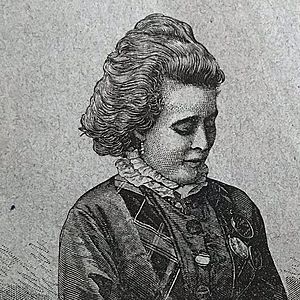Henrietta Vansittart facts for kids
Quick facts for kids
Henrietta Vansittart
|
|
|---|---|
 |
|
| Born | 1833 Ewell, Surrey, England
|
| Died | 8 February 1883 Gosforth, Cumberland, England
|
| Occupation | engineer |
| Known for | creating a novel design of propeller |
Henrietta Vansittart (born Henrietta Lowe in 1833 – died February 8, 1883) was an amazing English engineer and inventor. She created a special type of screw propeller called the Lowe-Vansittart propeller. Henrietta taught herself engineering and is known as one of the first female engineers. She focused on making ships move better and faster.
Contents
Henrietta's Early Life
Henrietta Lowe was born in Ewell, Surrey, England, in 1833. She was one of eight children. Her father, James Lowe, was a blacksmith and inventor. He worked on ways to make ships move and even got patents for his ideas.
Henrietta's father, James Lowe, got a patent for a new screw propeller in 1838. Even though his ideas were good, he didn't make much money from them because of other inventors. In 1855, Henrietta married a man named Frederick Vansittart.
Her Engineering Work
Henrietta Vansittart taught herself everything she knew about engineering. Like many women in engineering back then, she learned about it through her family. Her father, James Lowe, was her main inspiration.
Learning from Her Father
Soon after she got married, Henrietta started studying her father's work on ship propellers. In 1857, she even went with him on a ship called HMS Bullfinch to test a new propeller. This trip made her very interested in the field. Many British warships were already using her father's propeller design. But James Lowe never got the credit or money he deserved.
When her father died in 1866, Henrietta decided to continue his work. She wanted to get the recognition for his ideas that he never received.
The Lowe-Vansittart Propeller
In 1868, Henrietta got her own patent (British Patent no 2877). This was for an improved version of her father's propeller. She called it the Lowe-Vansittart propeller. She said her propeller helped ships go faster and smoother. It also used less fuel.
Her invention was used on many ships, including HMS Druid, the Scandinavian, and the SS Lusitania. She also got an American patent for her propeller design in 1869. In the 1860s, Henrietta made the propeller even better. She changed the blades from straight to curved. This made them work much more efficiently. Her home was full of models she built and tested!
Awards and Recognition
The Lowe-Vansittart Propeller won many awards. It received a top diploma at the International Exhibition in Kensington in 1871. It also won medals and diplomas at exhibitions in Dublin (1872), Paris (1875), Belgium (1876), Sydney (1879), Melbourne (1880), and Adelaide (1881). She also won awards at other maritime exhibitions.
Henrietta was mentioned in newspapers like The Times. Her invention took her to exhibitions all over the world.
In 1876, Henrietta Vansittart made history. She was the first woman to write, read, and show her own diagrams for a scientific article. She presented this paper to the Association of Foreman Engineers and Draughtsmen. A pamphlet based on her paper was published in 1882. It was called The History of the Lowe Vansittart Propeller. This showed how dedicated she was to her father's work. It also proved her deep knowledge of the propeller.
Henrietta's Personal Life
Henrietta Vansittart was very focused on her engineering work. She believed it was important to support her family's legacy. She thought a woman's main role was at home. However, she felt it was her duty to champion her father's inventions.
Her Legacy
In late 1882, Henrietta became ill. She was admitted to St Nicholas's Hospital in Gosforth. She passed away on February 8, 1883.
Her obituary in the Journal of the London Association of Foreman Engineers and Draughtsmen praised her. It said she was "a remarkable personage with a great knowledge of engineering matters." It also mentioned how kind and thoughtful she was.
The obituary also stated that Henrietta was the first woman to write and present a scientific paper with her own drawings. Thanks to her work, ships could move faster and use less fuel. They could also be steered better when going backward. She achieved all this at a time when there were no formal female engineers. She also had no official scientific training. Some people consider her work "one of the most important nautical inventions of the 19th century."
Henrietta donated a model of the Lowe-Vansittart propeller to the Science Museum in 1874. It is still part of their collection today.
Henrietta Vansittart did not have any children. Her husband passed away in 1902.
Images for kids


